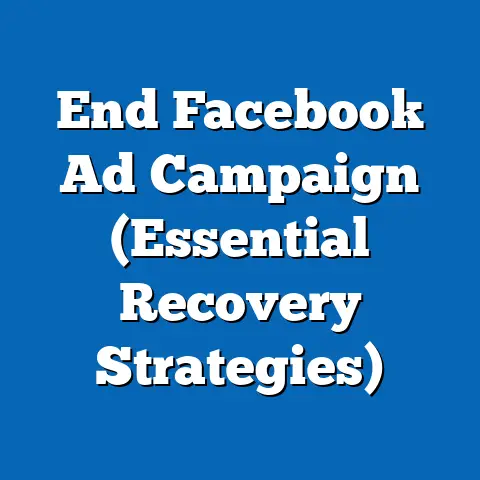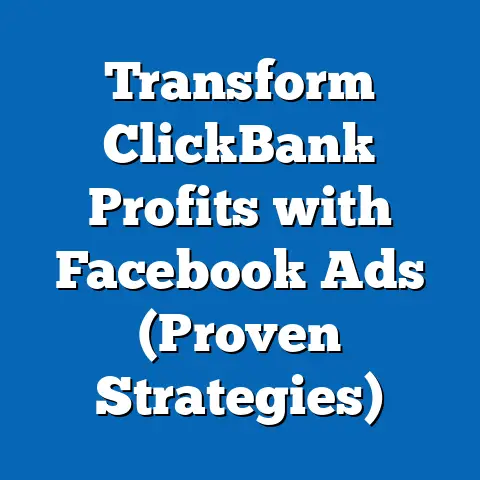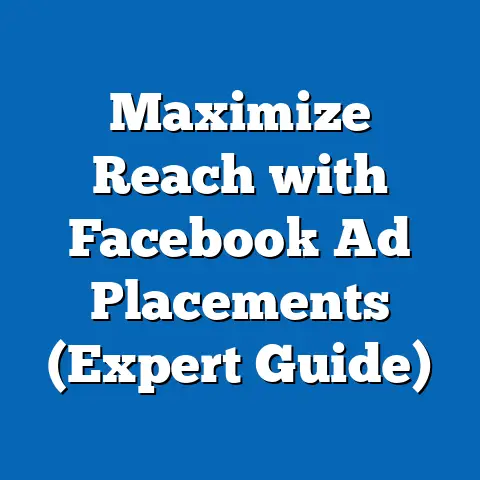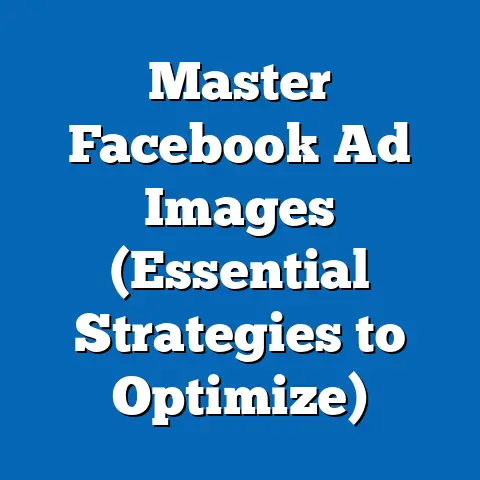Supercharge E-Commerce with Facebook Ads (Proven Strategies)
Understanding Facebook Ads for E-Commerce
The Power of Facebook Ads
Let’s be real: Facebook isn’t just a place to share vacation photos and argue about politics. It’s a colossal advertising platform with unparalleled reach. The sheer scale of Facebook’s user base is staggering. Think about it: nearly half the world’s population is actively scrolling through their Facebook feed. That’s an audience you simply can’t ignore.
But it’s not just about the numbers. What truly sets Facebook Ads apart is its incredibly granular targeting capabilities. You can target users based on demographics (age, location, gender), interests (hobbies, favorite brands, pages they like), behaviors (purchase history, online activity), and even connections (friends of people who like your page). This level of precision allows you to laser-focus your ads on the people most likely to buy your products, maximizing your ROI and minimizing wasted ad spend.
From my experience, the power of Facebook Ads lies in its ability to connect you with the right people at the right time with the right message. I’ve seen small e-commerce businesses explode in growth simply by leveraging the platform’s targeting options to reach niche audiences who were actively searching for their products.
Takeaway: Facebook’s massive user base and advanced targeting options make it an indispensable tool for e-commerce businesses looking to drive sales and grow their brand.
The E-Commerce Landscape
The e-commerce industry is booming, and it shows no signs of slowing down. We’re talking about a multi-trillion dollar market that’s constantly evolving. Digital marketing is no longer an option; it’s a necessity for survival. In this competitive landscape, standing out from the crowd requires a strategic approach to advertising.
According to Statista, e-commerce sales are projected to reach over \$6 trillion by 2024. This growth is fueled by increasing internet penetration, the rise of mobile commerce, and changing consumer habits. People are simply more comfortable buying things online than ever before.
But with this growth comes increased competition. Thousands of new e-commerce stores are popping up every day, all vying for the same customers. That’s why it’s crucial to have a strong digital marketing strategy in place, and Facebook Ads should be a key component of that strategy.
Takeaway: The e-commerce landscape is fiercely competitive, making effective digital marketing, particularly Facebook Ads, essential for driving sales and achieving sustainable growth.
Setting Up Your Facebook Ads for Success
Creating a Facebook Business Account
Before you can start running Facebook Ads, you need to create a Facebook Business Manager account. Think of it as your central hub for managing all your Facebook advertising activities. It’s separate from your personal Facebook profile and allows you to manage multiple ad accounts, pages, and users.
Here’s a step-by-step guide:
- Go to business.facebook.com: You’ll be prompted to log in with your personal Facebook account. Don’t worry, your personal information won’t be visible to the public.
- Click “Create Account”: Follow the on-screen instructions to enter your business name, email address, and other required information.
- Add Your Facebook Page: If you already have a Facebook Page for your business, you can add it to your Business Manager account. If not, you can create a new one.
- Create an Ad Account: This is where you’ll actually create and manage your ad campaigns. You’ll need to provide your business’s payment information.
- Add People: You can add other people to your Business Manager account and assign them different roles (e.g., admin, advertiser, analyst).
I remember when I first started using Facebook Ads, I tried to run everything through my personal account. It was a complete mess! Creating a Business Manager account was a game-changer. It allowed me to stay organized, collaborate with my team, and manage multiple ad accounts for different clients.
Takeaway: Setting up a Facebook Business Manager account is the first crucial step in launching successful Facebook ad campaigns. It provides a centralized platform for managing your advertising activities and collaborating with your team.
Defining Your Target Audience
One of the biggest mistakes I see e-commerce businesses make is failing to define their target audience. They try to appeal to everyone, which ultimately appeals to no one. You need to know exactly who you’re trying to reach with your ads.
Start by thinking about your ideal customer. What are their demographics (age, gender, location, income)? What are their interests (hobbies, favorite brands, pages they like)? What are their behaviors (purchase history, online activity)?
Facebook’s Audience Insights tool can be incredibly helpful in this process. It allows you to explore different audiences and see their demographics, interests, and behaviors. You can also use it to identify potential target markets you may not have considered before.
For example, let’s say you’re selling organic baby clothes. Your target audience might be parents aged 25-45 who are interested in organic products, sustainable living, and baby care. You could also target people who have recently purchased baby products online or who are members of parenting groups on Facebook.
Takeaway: Defining your target audience is crucial for the success of your Facebook ad campaigns. Use Facebook’s Audience Insights tool to research and identify your ideal customer and tailor your ads to their specific interests and needs.
Choosing the Right Ad Format
Facebook offers a variety of ad formats, each with its own strengths and weaknesses. Choosing the right ad format depends on your campaign goals, your target audience, and the type of products you’re selling.
Here are some of the most popular ad formats for e-commerce:
- Image Ads: Simple and effective, image ads are a great way to showcase your products and drive traffic to your website.
- Video Ads: Video ads are more engaging than image ads and can be used to tell a story, demonstrate your product, or showcase customer testimonials.
- Carousel Ads: Carousel ads allow you to display multiple images or videos in a single ad, each with its own link. This is a great way to showcase a range of products or highlight different features of a single product.
- Collection Ads: Collection ads are designed specifically for e-commerce businesses. They feature a main image or video with a selection of related products displayed below. When users click on a product, they’re taken to a full-screen experience where they can learn more and make a purchase.
- Instant Experience Ads: Instant Experience ads (formerly known as Canvas ads) are full-screen, mobile-optimized ads that load instantly when clicked. They can include a variety of elements, such as images, videos, text, and buttons.
I’ve found that carousel ads are particularly effective for e-commerce businesses because they allow you to showcase multiple products in a single ad. Video ads are also great for capturing attention and telling a story about your brand.
Takeaway: Facebook offers a variety of ad formats to suit different campaign goals and target audiences. Experiment with different formats to see what works best for your business. Carousel ads and video ads are often particularly effective for e-commerce.
Crafting Compelling Ads
Writing Engaging Ad Copy
Your ad copy is just as important as your visuals. It’s what captures people’s attention and convinces them to click on your ad.
Here are some tips for writing engaging ad copy:
- Know Your Audience: Tailor your message to your target audience. Use language that resonates with them and addresses their specific needs and interests.
- Highlight Benefits, Not Just Features: Focus on the benefits of your product, not just its features. Explain how it will solve a problem or make their life better.
- Use Strong Verbs: Use action words that create a sense of urgency and excitement.
- Keep It Concise: People have short attention spans, so get to the point quickly.
- Include a Clear Call to Action: Tell people exactly what you want them to do (e.g., “Shop Now,” “Learn More,” “Get a Free Quote”).
I always like to start my ad copy with a question or a statement that grabs people’s attention. For example, if you’re selling running shoes, you might start with something like, “Tired of sore feet after your runs?” or “Experience the ultimate comfort and performance with our new running shoes.”
Takeaway: Writing engaging ad copy is crucial for capturing attention and driving clicks. Know your audience, highlight benefits, use strong verbs, keep it concise, and include a clear call to action.
Designing Eye-Catching Visuals
Your visuals are the first thing people see, so they need to be eye-catching and relevant to your product.
Here are some guidelines for designing effective visuals:
- Use High-Quality Images: Use images that are clear, sharp, and well-lit.
- Showcase Your Products: Highlight your products in the best possible light.
- Use Lifestyle Images: Show your products in use in real-life settings.
- Use Consistent Branding: Use your brand colors, fonts, and logo to create a consistent look and feel.
- Optimize for Mobile: Make sure your visuals look good on mobile devices, as most people will be seeing your ads on their phones.
I’ve found that using lifestyle images is particularly effective for e-commerce businesses. People want to see how your products will fit into their lives. They want to imagine themselves using them and enjoying the benefits.
Takeaway: Eye-catching visuals are essential for capturing attention and driving engagement. Use high-quality images, showcase your products, use lifestyle images, use consistent branding, and optimize for mobile.
A/B Testing Your Ads
A/B testing (also known as split testing) is the process of comparing two versions of an ad to see which one performs better. It’s a crucial part of optimizing your Facebook ad campaigns.
Here’s how it works:
- Choose a Variable to Test: You can test different headlines, ad copy, visuals, calls to action, or targeting options.
- Create Two Versions of Your Ad: Create two versions of your ad that are identical except for the variable you’re testing.
- Run Your Ads: Run your ads for a set period of time and track their performance.
- Analyze the Results: Analyze the data to see which version of the ad performed better.
- Implement the Winner: Implement the winning version of the ad in your campaign.
I always recommend A/B testing multiple variables at the same time. This allows you to quickly identify the most effective combinations of elements.
Takeaway: A/B testing is crucial for optimizing your Facebook ad campaigns. Test different variables, analyze the results, and implement the winning versions to improve your ad performance.
Advanced Targeting Strategies
Retargeting Campaigns
Retargeting is the process of showing ads to people who have already interacted with your business in some way (e.g., visited your website, viewed a product, added an item to their cart). It’s a highly effective way to re-engage visitors who didn’t convert initially.
Here’s how it works:
- Install the Facebook Pixel: The Facebook Pixel is a piece of code that you install on your website. It tracks the actions that people take on your website, such as visiting pages, viewing products, and adding items to their cart.
- Create a Custom Audience: Create a custom audience of people who have taken specific actions on your website.
- Create a Retargeting Campaign: Create a retargeting campaign that targets your custom audience.
- Show Targeted Ads: Show targeted ads to people in your custom audience, reminding them of the products they viewed or the items they added to their cart.
I’ve seen retargeting campaigns generate some of the highest ROI for e-commerce businesses. People who have already shown interest in your products are much more likely to convert than people who have never heard of you before.
Takeaway: Retargeting is a highly effective way to re-engage visitors who didn’t convert initially. Install the Facebook Pixel, create custom audiences, and show targeted ads to remind people of your products and encourage them to make a purchase.
Lookalike Audiences
Lookalike Audiences allow you to find new customers who are similar to your existing ones. Facebook analyzes your existing customer data (e.g., email list, website visitors) and identifies common characteristics. It then uses this information to find other people on Facebook who share those same characteristics.
Here’s how it works:
- Create a Source Audience: Create a source audience of your best customers. This could be an email list of your top purchasers, a custom audience of people who have spent a certain amount of money on your website, or a lookalike audience based on your existing customer base.
- Create a Lookalike Audience: Create a lookalike audience based on your source audience. You can choose the size of your lookalike audience (from 1% to 10% of the population in your target country). A smaller percentage will be more similar to your source audience, while a larger percentage will be less similar but will have a larger reach.
- Target Your Lookalike Audience: Target your lookalike audience with your ads.
I’ve found that lookalike audiences are a great way to scale your Facebook ad campaigns. They allow you to reach a large number of potential customers who are likely to be interested in your products.
Takeaway: Lookalike Audiences are a powerful way to find new customers who are similar to your existing ones. Create a source audience of your best customers and use it to create a lookalike audience that you can target with your ads.
Custom Audiences
Custom Audiences allow you to target people who have already interacted with your business in some way, either online or offline. You can create custom audiences based on a variety of sources, including:
- Customer Lists: Upload a list of your customer email addresses or phone numbers.
- Website Traffic: Target people who have visited your website or specific pages on your website.
- App Activity: Target people who have used your mobile app.
- Offline Activity: Target people who have interacted with your business offline (e.g., made a purchase in your store, attended an event).
- Engagement: Target people who have engaged with your content on Facebook or Instagram (e.g., liked your page, watched your videos, clicked on your ads).
I often use custom audiences to target people who have abandoned their shopping carts. I show them ads reminding them of the items they left behind and offering them a discount to complete their purchase.
Takeaway: Custom Audiences allow you to target people who have already interacted with your business in some way. Use them to re-engage past customers, target people who have abandoned their shopping carts, and reach people who have engaged with your content on Facebook and Instagram.
Budgeting and Bidding Strategies
Setting Your Budget
Setting a budget for your Facebook ad campaigns can be tricky. You want to spend enough to reach your target audience and achieve your goals, but you don’t want to waste money on ads that aren’t performing well.
Here are some tips for setting your budget:
- Start Small: Start with a small budget and gradually increase it as you see results.
- Consider Your Goals: Your budget should be based on your campaign goals. If you’re trying to drive sales, you’ll need a larger budget than if you’re just trying to build brand awareness.
- Use Daily vs. Lifetime Budgets: You can set a daily budget or a lifetime budget. A daily budget is the average amount you’re willing to spend each day, while a lifetime budget is the total amount you’re willing to spend over the entire campaign.
- Monitor Your Performance: Monitor your ad performance closely and adjust your budget accordingly. If your ads are performing well, you can increase your budget to reach more people. If they’re not performing well, you can decrease your budget or pause your campaign.
I typically recommend starting with a daily budget of \$5-\$10 per ad set. As you see results, you can gradually increase your budget.
Takeaway: Setting a budget for your Facebook ad campaigns requires careful consideration. Start small, consider your goals, use daily vs. lifetime budgets strategically, and monitor your performance closely to adjust your budget accordingly.
Understanding Bidding Options
Facebook offers a variety of bidding options, each with its own advantages and disadvantages. Choosing the right bidding option depends on your campaign goals and your budget.
Here are some of the most common bidding options:
- Cost Per Click (CPC): You pay each time someone clicks on your ad. This is a good option if you’re trying to drive traffic to your website.
- Cost Per Impression (CPM): You pay each time your ad is shown to someone. This is a good option if you’re trying to build brand awareness.
- Cost Per Action (CPA): You pay each time someone takes a specific action, such as making a purchase or filling out a form. This is a good option if you’re trying to drive conversions.
- Automated Bidding: Facebook automatically sets your bids based on your campaign goals. This is a good option if you’re new to Facebook Ads or if you don’t want to spend a lot of time managing your bids.
I often use automated bidding for my campaigns because it saves me time and effort. However, it’s important to monitor your performance closely to make sure you’re getting the results you want.
Takeaway: Understanding Facebook’s bidding options is crucial for optimizing your ad spend. Choose the right bidding option based on your campaign goals and monitor your performance closely to adjust your bids accordingly.
Measuring and Analyzing Performance
Key Metrics to Track
Tracking the right metrics is essential for understanding how your Facebook ad campaigns are performing and making data-driven decisions.
Here are some of the key metrics to track:
- Click-Through Rate (CTR): The percentage of people who see your ad and click on it. A high CTR indicates that your ad is relevant and engaging.
- Conversion Rate: The percentage of people who click on your ad and then take a desired action, such as making a purchase or filling out a form. A high conversion rate indicates that your landing page is effective and that your offer is compelling.
- Cost Per Click (CPC): The average amount you pay each time someone clicks on your ad. A low CPC indicates that you’re targeting the right audience and that your ads are relevant.
- Cost Per Acquisition (CPA): The average amount you pay each time someone takes a desired action. A low CPA indicates that your campaigns are efficient and that you’re getting a good return on your investment.
- Return on Ad Spend (ROAS): The amount of revenue you generate for every dollar you spend on advertising. A high ROAS indicates that your campaigns are profitable.
I always focus on ROAS as my primary metric. It gives me a clear picture of how much money I’m making for every dollar I spend on advertising.
Takeaway: Tracking key metrics is essential for understanding how your Facebook ad campaigns are performing. Focus on CTR, conversion rate, CPC, CPA, and ROAS to make data-driven decisions and optimize your campaigns for maximum profitability.
Using Facebook Ads Manager
Facebook Ads Manager is your central hub for managing and analyzing your Facebook ad campaigns. It provides a wealth of data and insights that you can use to optimize your campaigns and improve your results.
Here are some of the things you can do with Facebook Ads Manager:
- Create and Manage Campaigns: Create new campaigns, ad sets, and ads.
- Track Your Performance: Monitor your ad performance in real-time.
- Analyze Your Data: Analyze your data to identify trends and patterns.
- Optimize Your Campaigns: Make changes to your campaigns to improve your results.
- Generate Reports: Generate reports to track your progress and share your results with others.
I spend a lot of time in Facebook Ads Manager, analyzing my data and making adjustments to my campaigns. It’s a powerful tool that can help you achieve your advertising goals.
Takeaway: Facebook Ads Manager is a powerful tool for managing and analyzing your Facebook ad campaigns. Use it to track your performance, analyze your data, optimize your campaigns, and generate reports.
Making Data-Driven Decisions
The key to success with Facebook Ads is to make data-driven decisions. Don’t rely on gut feelings or assumptions. Instead, use the data from Facebook Ads Manager to guide your decisions.
Here are some examples of how you can use data to optimize your campaigns:
- If your CTR is low: Try testing different headlines, ad copy, or visuals.
- If your conversion rate is low: Try improving your landing page or offering a discount.
- If your CPC is high: Try targeting a different audience or using a different bidding option.
- If your CPA is high: Try optimizing your landing page or improving your ad targeting.
- If your ROAS is low: Try optimizing your entire funnel, from your ads to your landing page to your checkout process.
I’ve seen countless businesses transform their Facebook ad performance simply by paying attention to the data and making informed decisions.
Takeaway: Making data-driven decisions is crucial for success with Facebook Ads. Use the data from Facebook Ads Manager to identify areas for improvement and optimize your campaigns for maximum profitability.
Case Studies of Successful E-Commerce Brands
Brand A: A Success Story
Let’s take a look at a real-world example of an e-commerce brand that has successfully utilized Facebook Ads. I worked with “EcoThreads,” a sustainable clothing brand, to revamp their Facebook advertising strategy.
The Challenge: EcoThreads had beautiful, high-quality products but struggled to reach their target audience effectively. Their existing campaigns were generating some traffic, but the conversion rates were low, and the ROAS was disappointing.
The Strategy:
- Audience Research: We started by conducting thorough audience research using Facebook’s Audience Insights tool. We identified key demographics, interests, and behaviors of EcoThreads’ ideal customers.
- Targeted Ad Copy & Visuals: We crafted ad copy that highlighted the sustainability and ethical sourcing of EcoThreads’ clothing. We also used high-quality lifestyle images that showcased the clothes in real-world settings.
- Carousel Ads: We utilized carousel ads to showcase a variety of EcoThreads’ products in a single ad.
- Retargeting: We implemented a retargeting campaign to target people who had visited the EcoThreads website but hadn’t made a purchase.
- Lookalike Audiences: We created lookalike audiences based on EcoThreads’ existing customer base to reach new potential customers.
The Results:
- CTR Increased by 150%: The targeted ad copy and visuals resonated with the target audience, resulting in a significant increase in CTR.
- Conversion Rate Increased by 200%: The retargeting campaign was highly effective in re-engaging visitors and driving conversions.
- ROAS Increased by 300%: The overall campaign resulted in a dramatic increase in ROAS, making EcoThreads’ Facebook advertising highly profitable.
Key Takeaway: By combining thorough audience research, targeted ad copy and visuals, carousel ads, retargeting, and lookalike audiences, EcoThreads was able to transform their Facebook advertising performance and achieve significant growth.
Brand B: Lessons Learned
“GadgetGeek,” an e-commerce store selling tech gadgets, provides a valuable case study in learning from mistakes.
The Challenge: GadgetGeek initially launched their Facebook ad campaigns without a clear understanding of their target audience or a well-defined strategy. They were running generic ads that weren’t resonating with anyone, resulting in low CTRs and high CPAs.
The Mistakes:
- Lack of Audience Segmentation: GadgetGeek was targeting a broad audience with no specific interests or behaviors.
- Generic Ad Copy & Visuals: Their ad copy was bland and uninspired, and their visuals were low-quality and irrelevant.
- No Retargeting: They weren’t retargeting visitors who had shown interest in their products.
- Ignoring Data: They weren’t tracking their ad performance or making data-driven decisions.
The Turnaround:
- Audience Research: GadgetGeek conducted in-depth audience research to identify their target customers.
- Targeted Ad Copy & Visuals: They created targeted ad copy and visuals that highlighted the unique features and benefits of their gadgets.
- Retargeting: They implemented a retargeting campaign to target visitors who had viewed specific products.
- A/B Testing: They started A/B testing different ad copy, visuals, and targeting options to optimize their campaigns.
- Data Analysis: They began tracking their ad performance and making data-driven decisions.
The Results:
- CTR Increased by 100%: The targeted ad copy and visuals resonated with the target audience, resulting in a significant increase in CTR.
- CPA Decreased by 50%: The retargeting campaign was highly effective in driving conversions at a lower cost.
- ROAS Increased by 200%: The overall campaign resulted in a dramatic increase in ROAS.
Key Takeaway: GadgetGeek’s experience highlights the importance of audience research, targeted ad copy and visuals, retargeting, A/B testing, and data analysis. By learning from their mistakes and implementing these strategies, they were able to transform their Facebook advertising performance and achieve significant growth.
Conclusion
Facebook Ads offer an unparalleled opportunity to supercharge your e-commerce business. With its massive reach, granular targeting capabilities, and a wide range of ad formats, Facebook provides the tools you need to connect with your ideal customers and drive sales.
Throughout this guide, I’ve shared proven strategies for setting up your Facebook Ads for success, crafting compelling ads, implementing advanced targeting strategies, managing your budget and bidding, measuring and analyzing your performance, and learning from real-world case studies.
Remember, success with Facebook Ads requires a strategic approach, a willingness to experiment, and a commitment to data-driven decision-making. Don’t be afraid to try new things, track your results, and adjust your strategies as needed.
Now, it’s time to take action. Implement the proven strategies outlined in this article to harness the full potential of Facebook advertising for your e-commerce growth. The world of e-commerce is waiting, and with the power of Facebook Ads, you’re well-equipped to conquer it!






